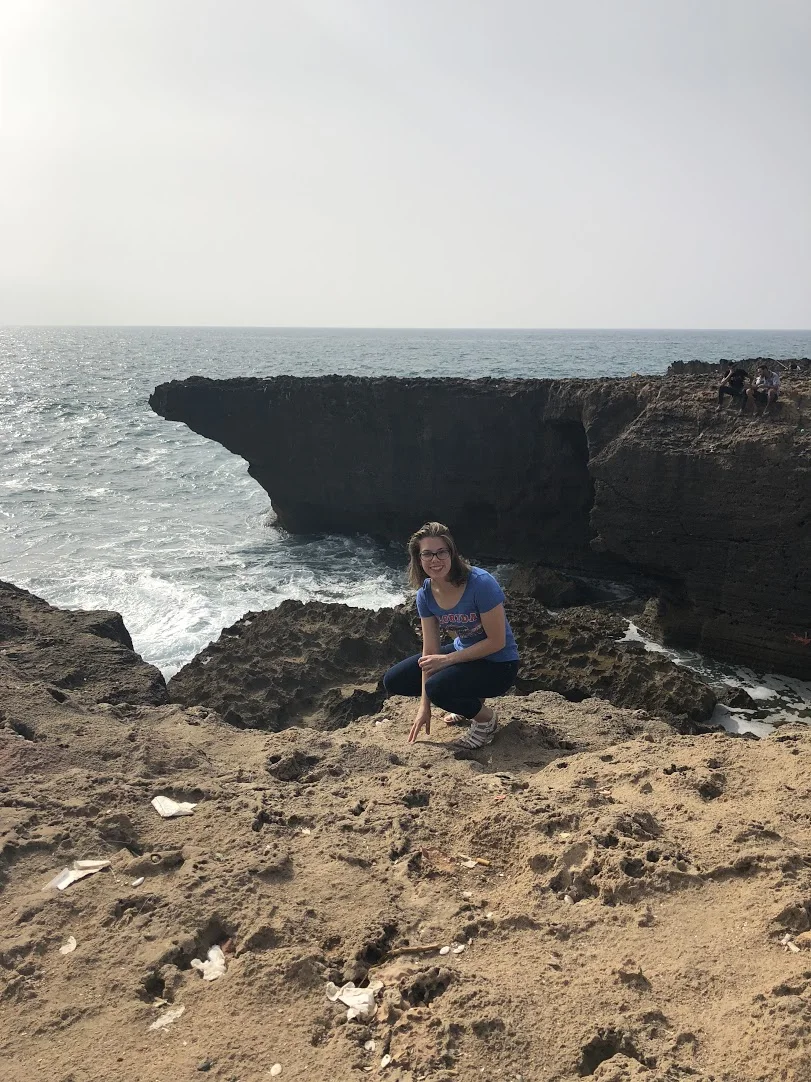"Moroccan Bread-Making: Recipes for Rghifa and Harcha" by Gwenyth Szabo
Along the streets throughout Morocco, you can find a مقلة (maqlah- a large griddle that goes on top of a stove) where usually women are preparing a variety of Moroccan breads in a small shop. The griddle is typically facing the road with a glass display case on one side and a counter on the other, so one can observe the woman prepare the dough on the counter, cook it on the griddle, and place the finished product in the case next to it. Most Moroccan families know how to make the bread themselves, but they often do not have the time. Instead, people can purchase freshly baked, homemade bread without having to make it themselves.
Behind the griddle out front, you can find Moroccans preparing the bread to be cooked. In this image, the woman is spreading the dough to make rghifa; the folded ones still must be stretched before going on the grill. Photo Credit: G. Szabo, Fall 2018.
During my time in Morocco, I had the opportunity to learn first-hand how these shops produce the breads. One of the optional excursions sponsored by Amideast is learning how to make rghifa and harcha. Rghifa is similar to filo dough but with the thickness and taste like a crepe, while harcha is shaped like a hamburger patty but tastes like semolina or cornbread. The bread is typically served with mint tea or coffee and eaten at breakfast plain or with a variety of spreads, including laughing cow cheese, apricot jam, olive oil, honey, and butter.
The best part of making bread was sharing it with my family and enjoying it the next day at breakfast. Photo Credit: G. Szabo, Fall 2018.
To participate in the cultural activity involved traveling to the very end of the Rabat-Sale tram route and taxiing deep into Sale. A very nice woman met us near a café and led us to her family’s shop. The shop has been in the family for generations, and it will be passed down the lineage when the current owner passes away. As we approached the shop, another woman at the front moved the stove aside for us to enter. We walked past the viewable kitchen to the back, where the ingredients are stored, and where a small table and two large bowls were waiting. The woman let each participant add ingredients and mix them together. Because of her expertise, she knew how to assemble the dough simply by how many handfuls we added, without using measurements. Once we prepared it and let it sit, we cooked the breads on a small griddle in the back.
We used a small griddle in the back of the shop, and in this picture, Katie is checking each harcha to see if they are ready to be turned. Photo Credit: Fatimazahra, Fall 2018.
This was the finished rghifa we made next to the ones waiting to stretched for the griddle. Photo Credit: Fatimazahra, Fall 2018.
It was a privilege to be able to participate in a daily Moroccan custom, and the family was very kind. As we were taxing back to the tram station, we went through all of the steps and assigned measurements to them that I have included below.
Rghifa: رغيفة
⁃ 2 cups of flour
⁃ 1 cup of semolina
⁃ Teaspoon of baking powder
⁃ Teaspoon of active yeast
⁃ 1 cup hot water
⁃ Tablespoon of sugar
1. Combine all ingredients
2. Knead dough until smooth and sticky (use butter and oil to keep it from sticking to your hands)
3. Form dough into balls using squeezing through fist method (see image of Katie)
4. Let sit for 10-15 minutes
5. Place olive oil on a flat surface
6. Stretch out the ball of dough as thin as possible, fold top and bottom edges into the center and rub with oil and semolina
7. Fold the right edge into the center and left edge over it and rub with oil and semolina (the dough should be a square shape)
8. Let rest for 5 minutes
9. Stretch out again, putting more oil on both sides
10. Place dough on hot griddle
11. Put more oil on one side before flipping (both sides should be speckled brown)
Katie knew how to shape the dough perfectly by smoothing it out and squeezing the bottom. Photo Credit: Fatimazahra 2018.
The dough was extremely sticky, but covering my hands in oil prevented it from sticking. Photo Credit: Fatimazahra 2018.
Harcha: حرشة
⁃ 4 cups of semolina
⁃ 2 tablespoons baking powder
⁃ 2 tablespoons of active yeast
⁃ Tablespoon of salt
⁃ Handful of sugar
⁃ Cookie cutter with three-inch diameter
1. Combine all ingredients
2. Add oil to moisten and add water until mushy
3. Let sit until yeast blooms (10-15 min)
4. Take handful and roll into a ball
5. Spread semolina on a flat surface and lightly roll ball in it
6. Place cookie cutter on griddle
7. Press dough into the cookie cutter and sprinkle semolina on top
8. Remove cutter
9. Press down with a spatula to flatten
10. Cook until brown on both sides and bread is firm






